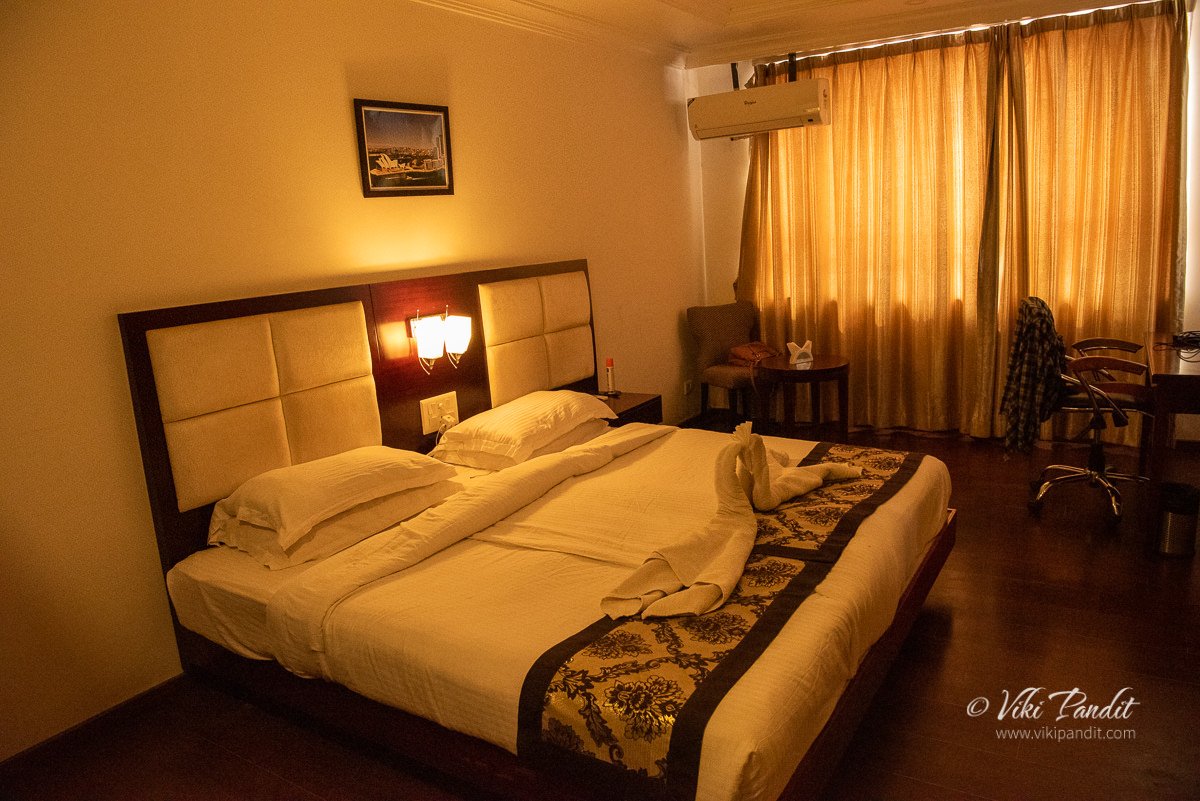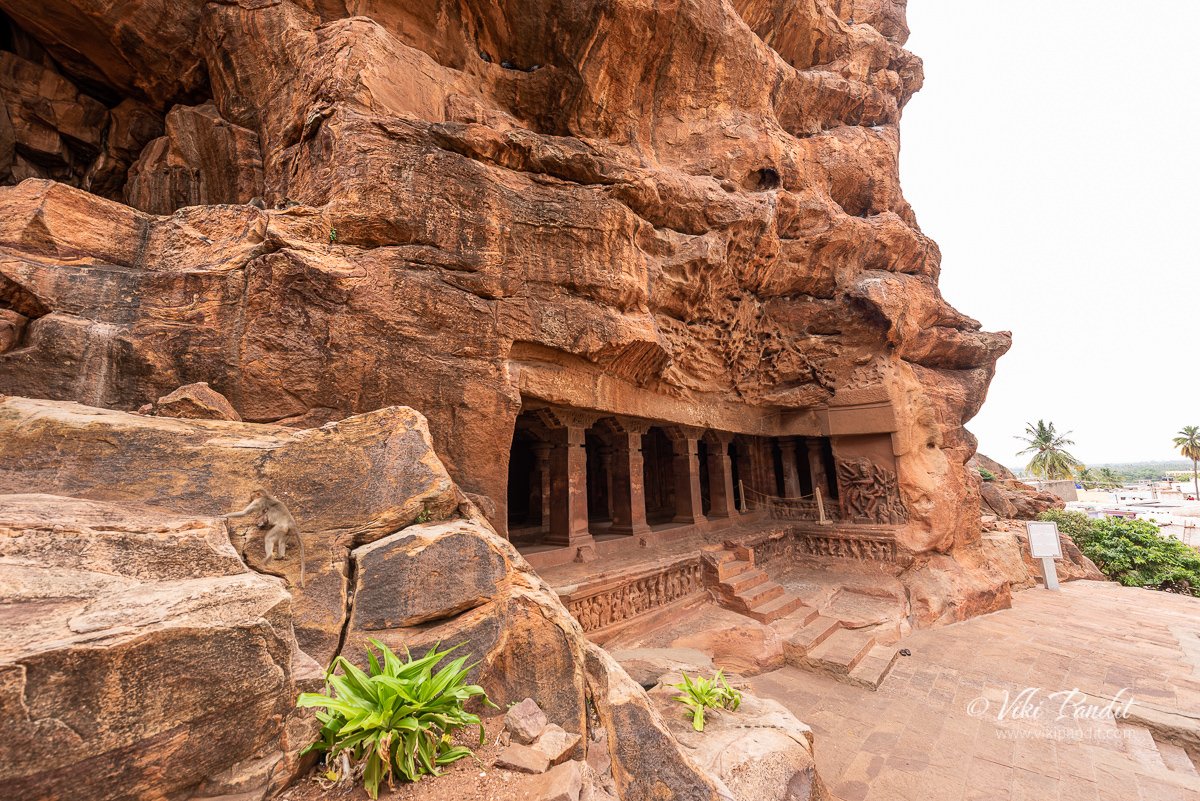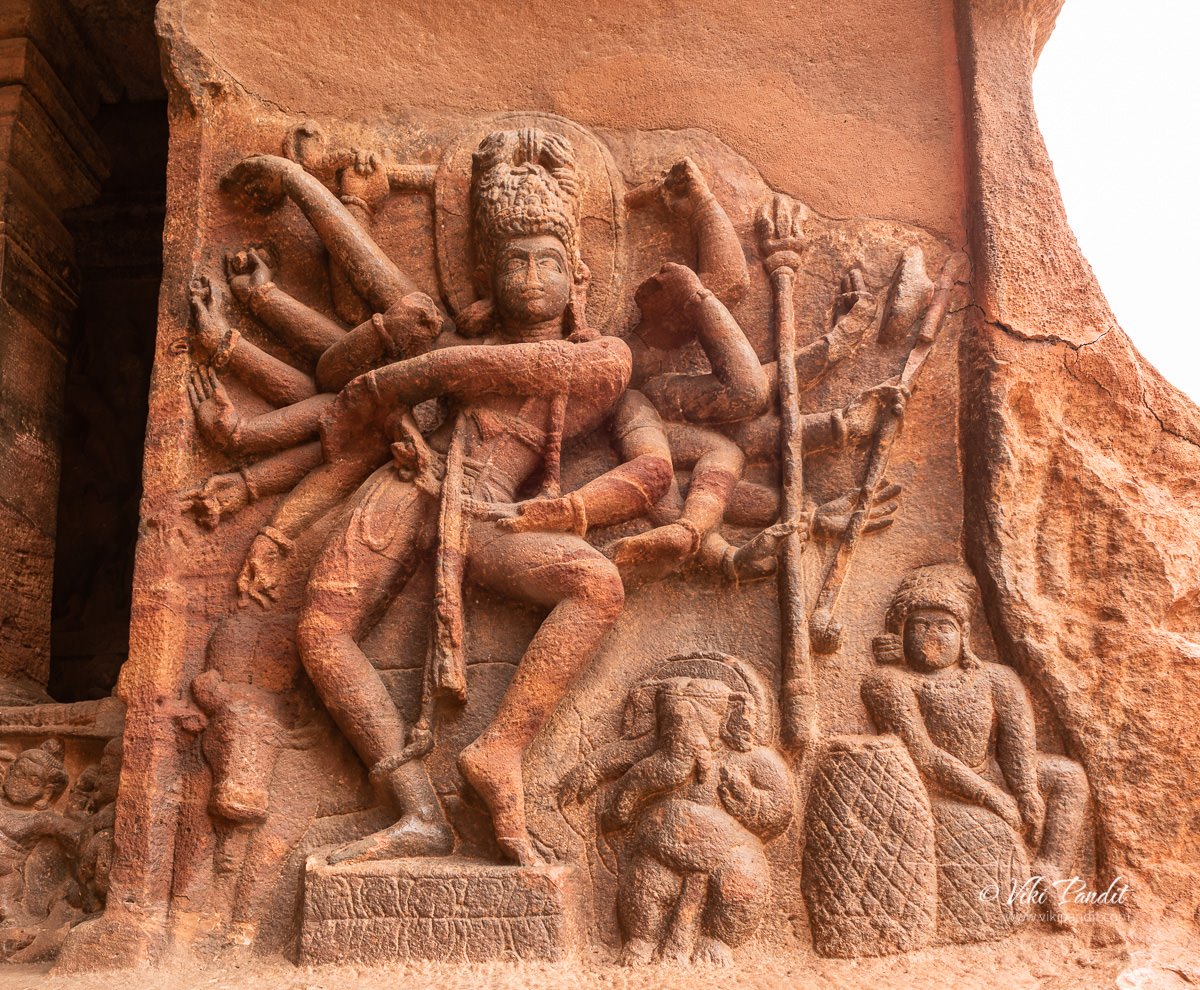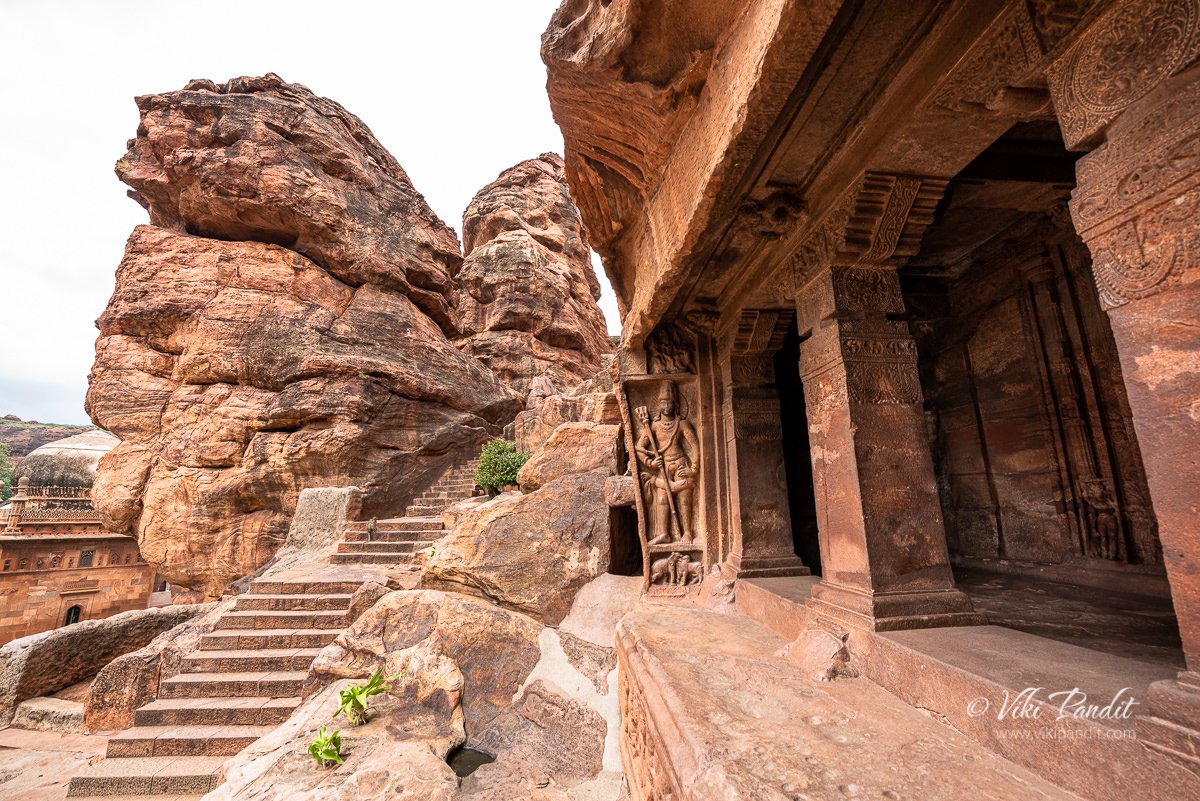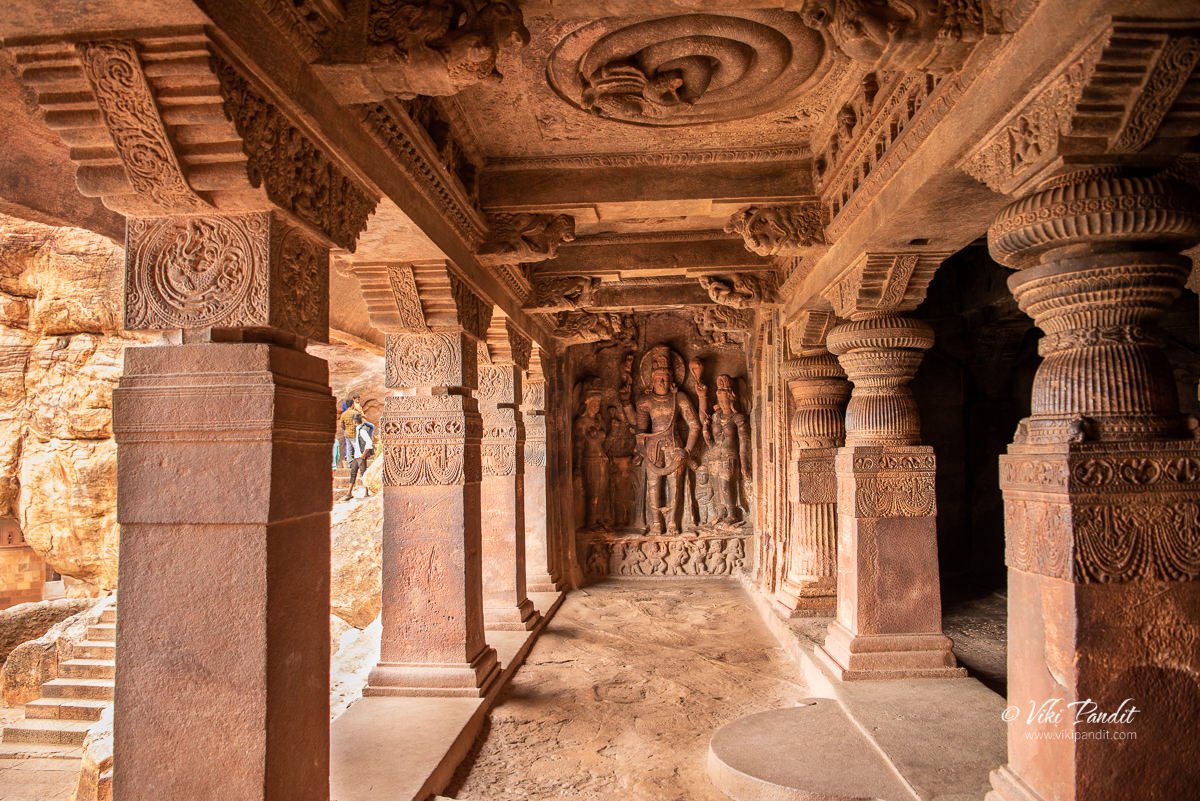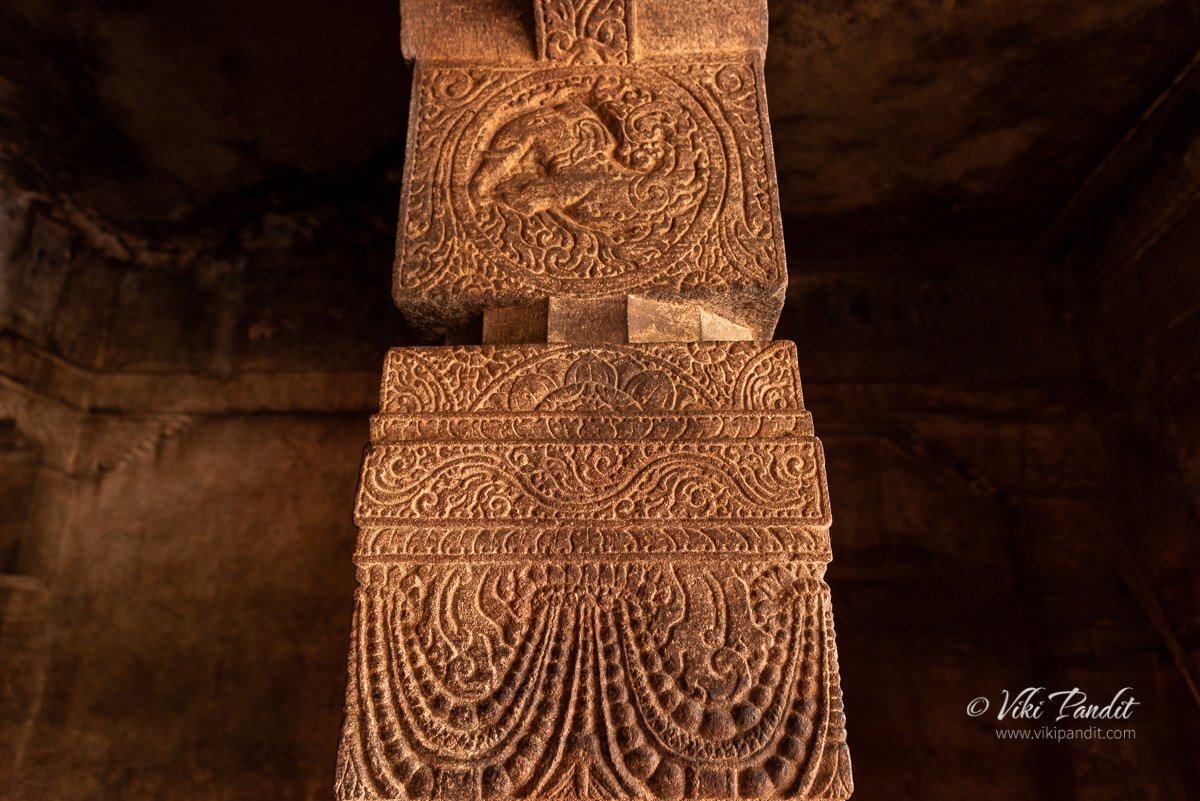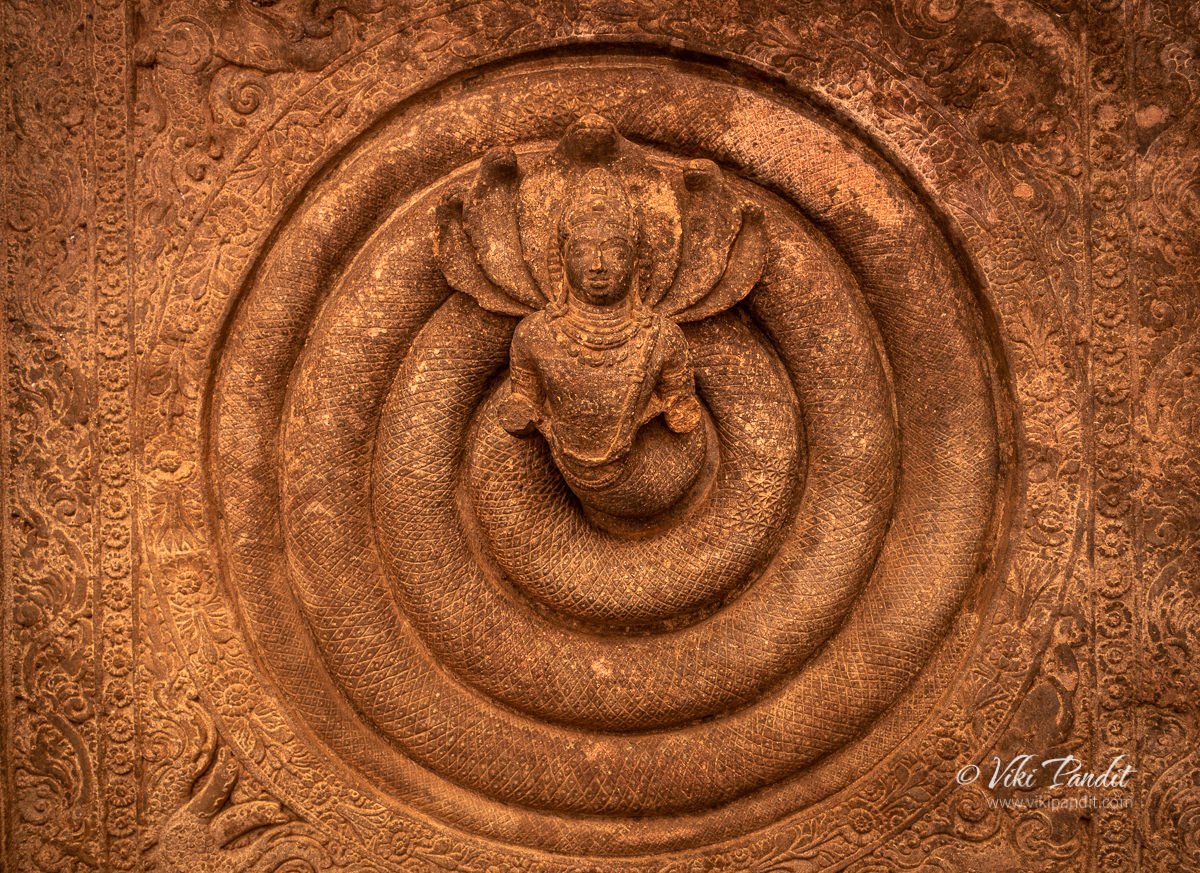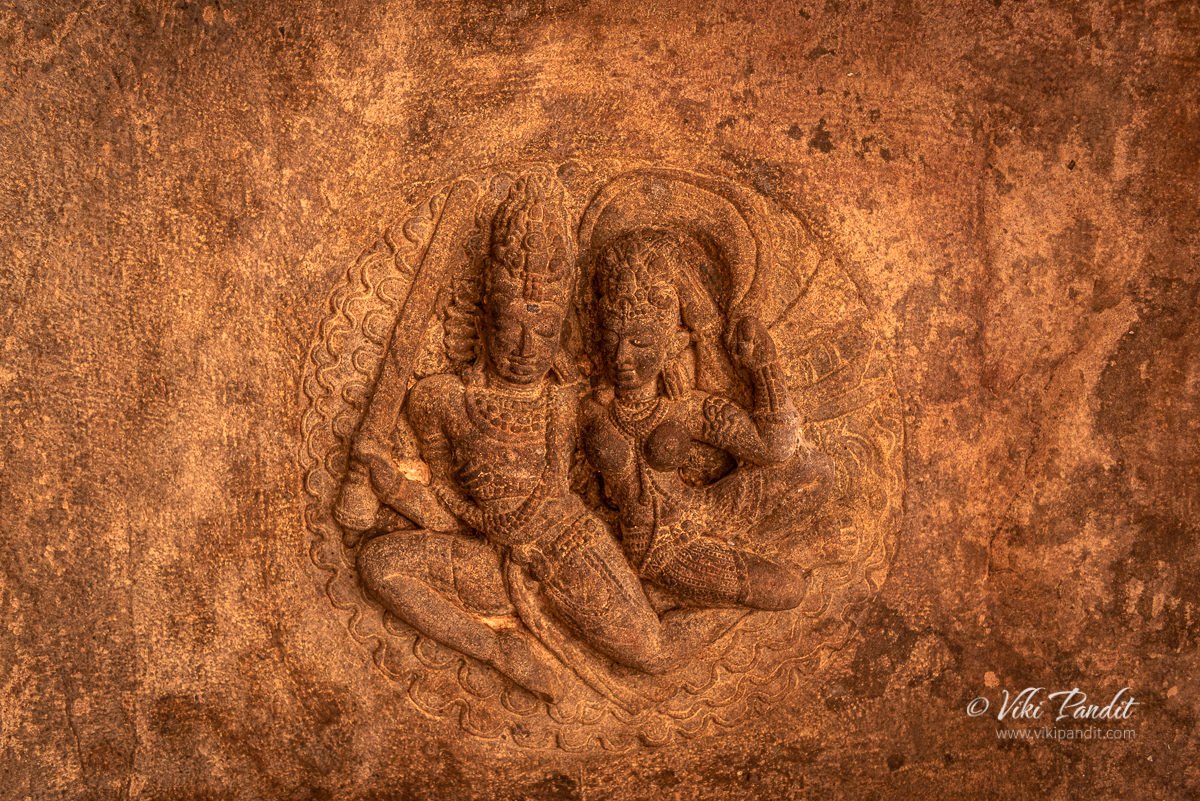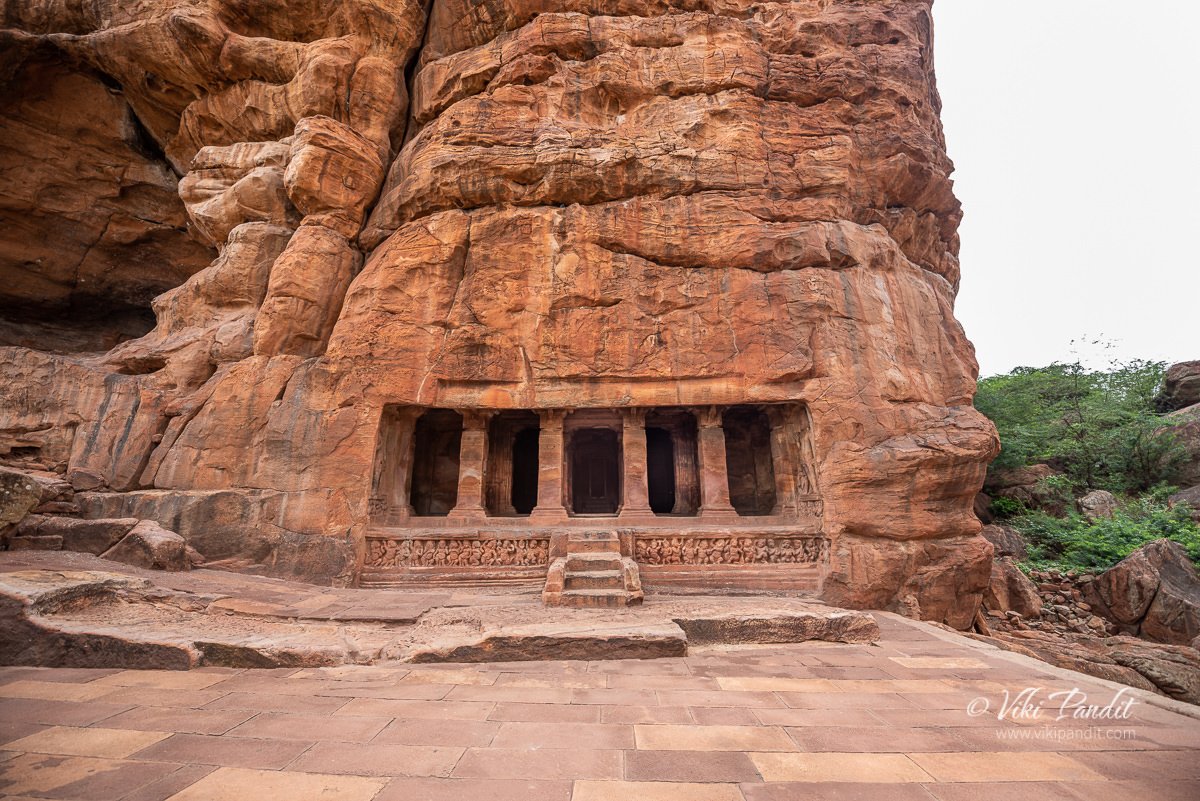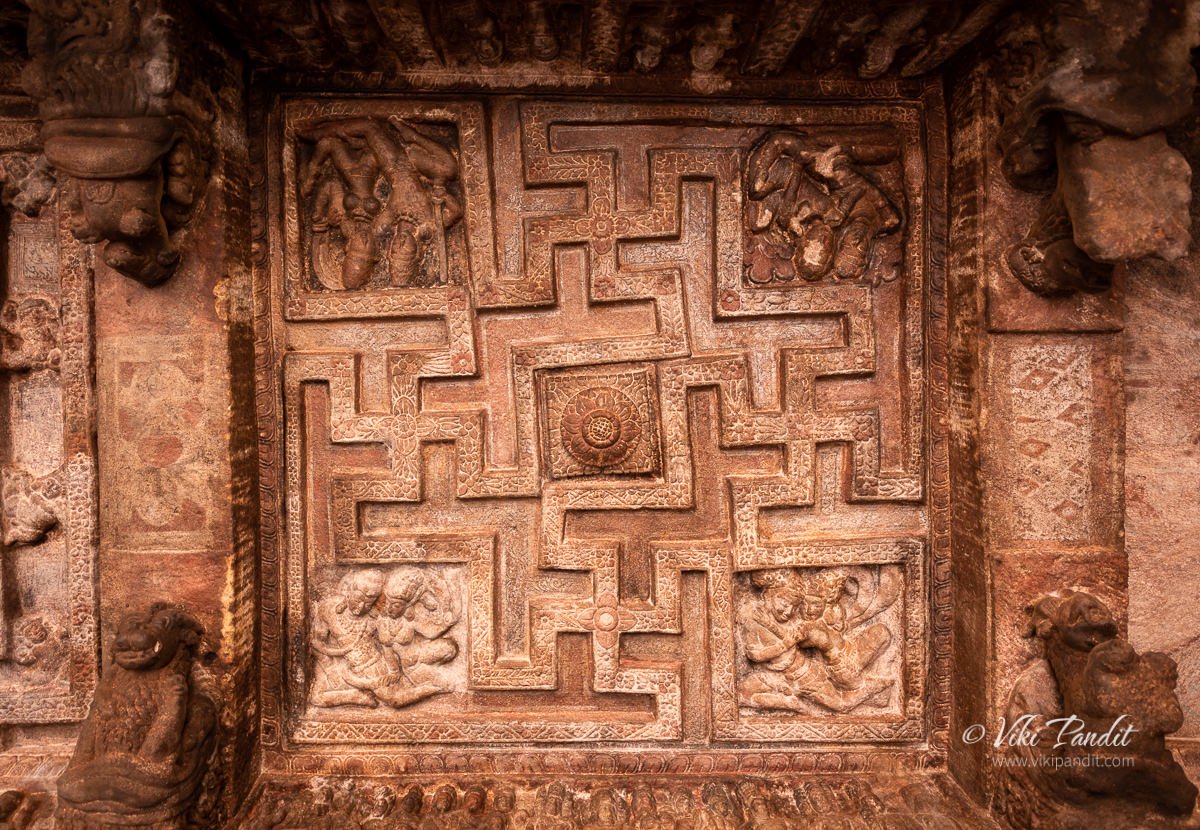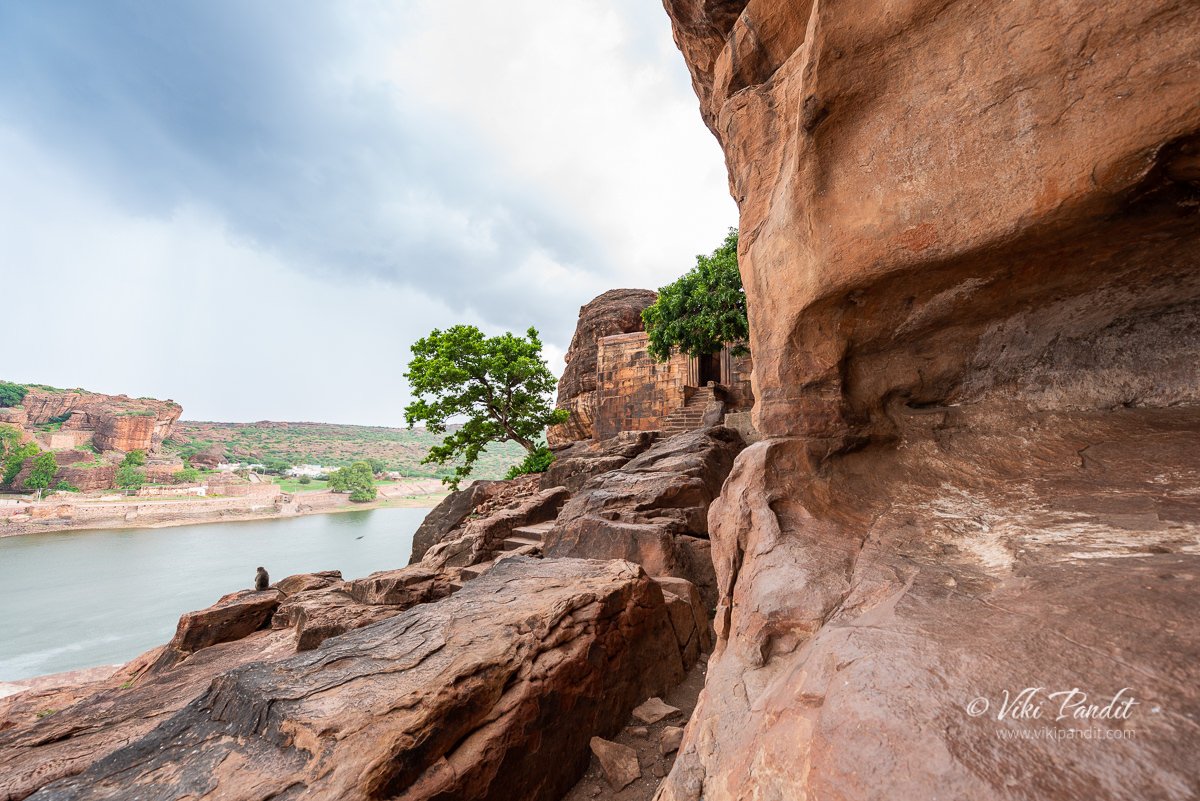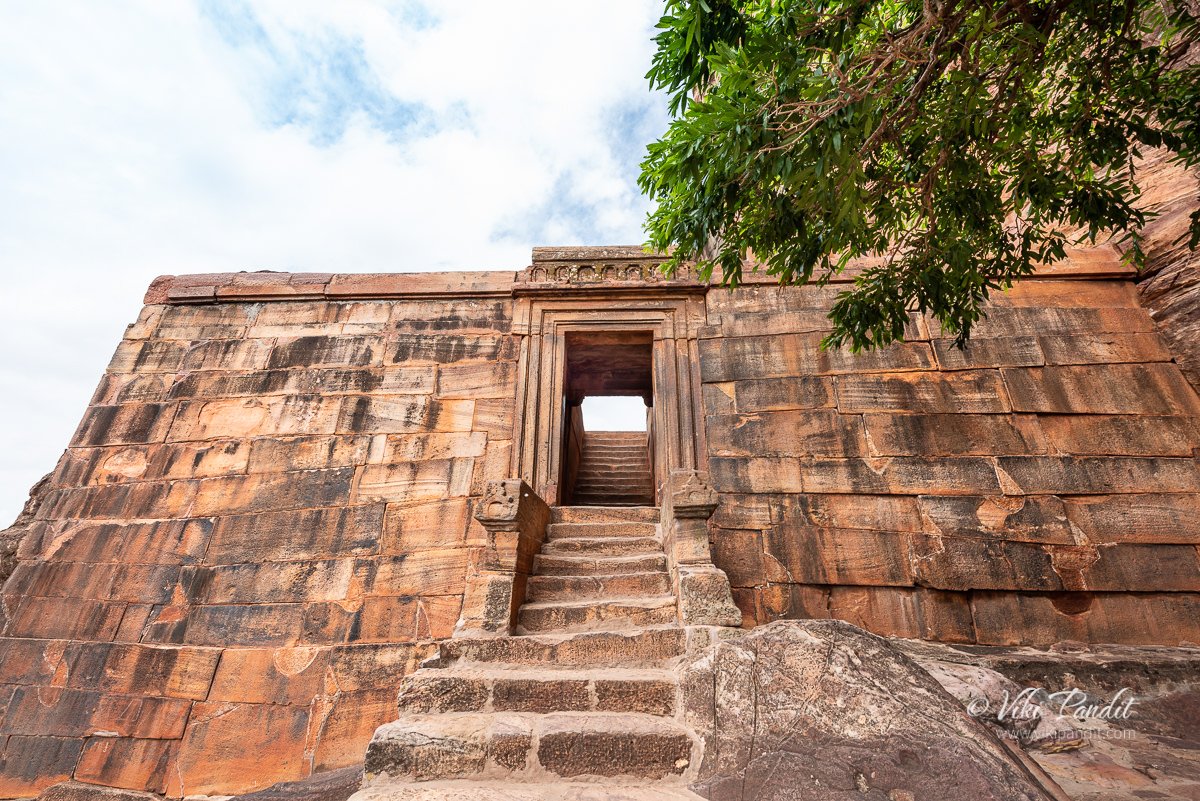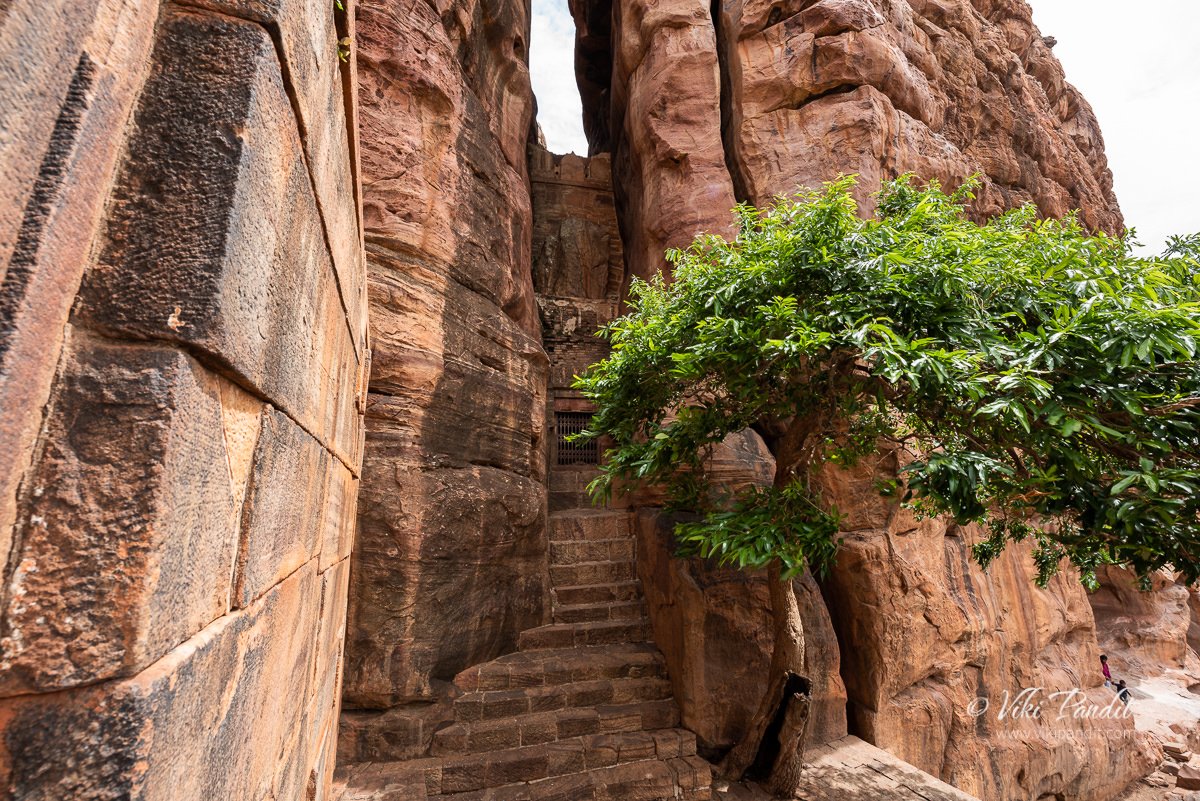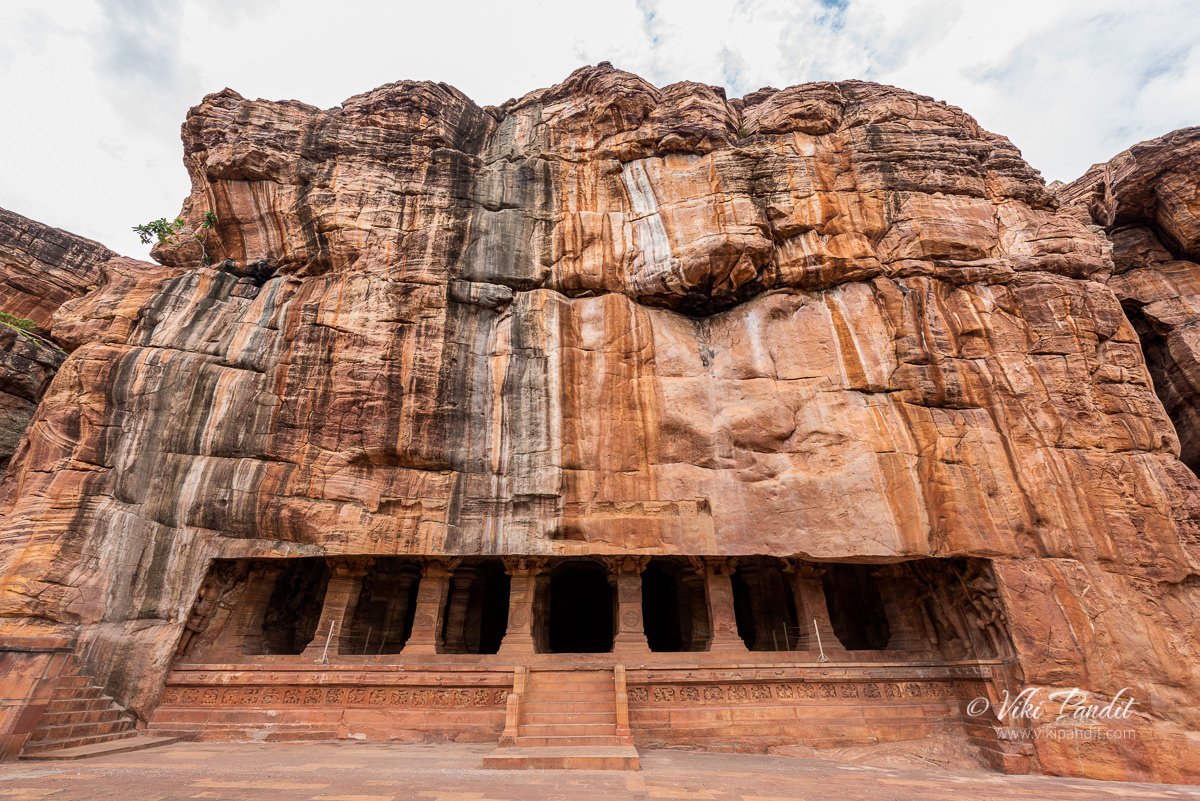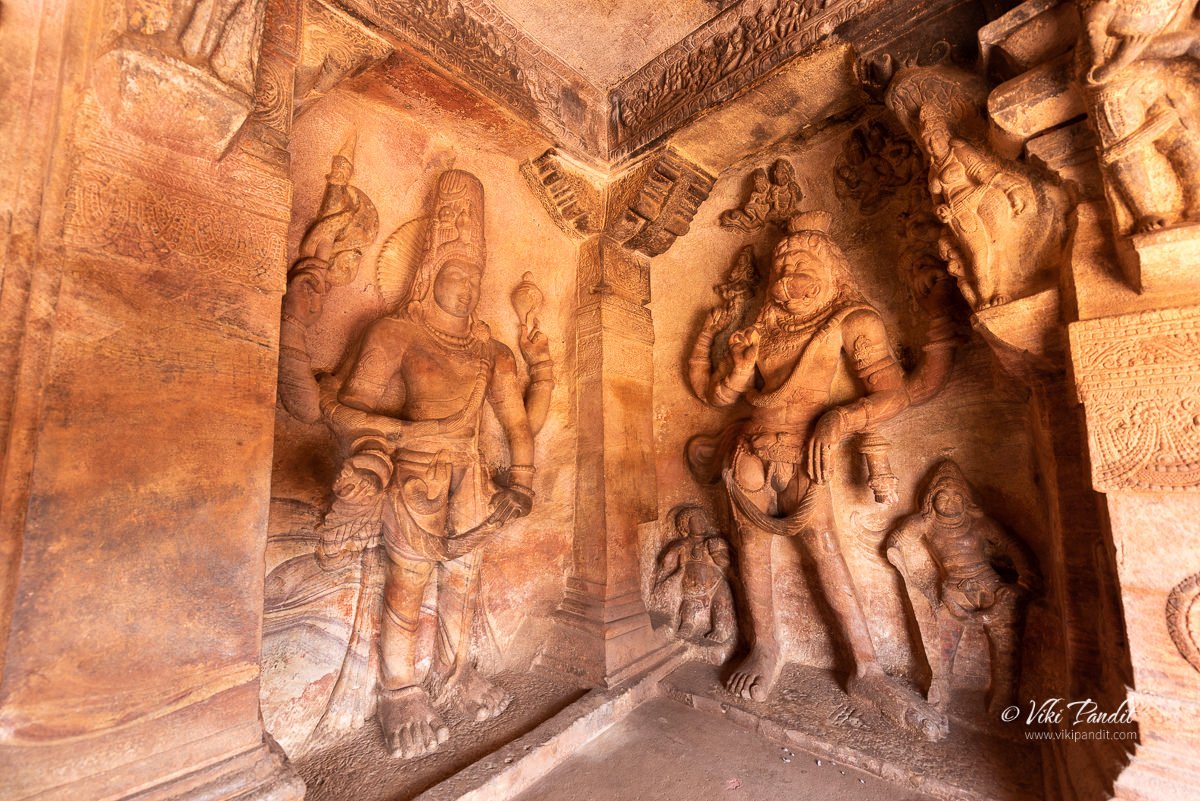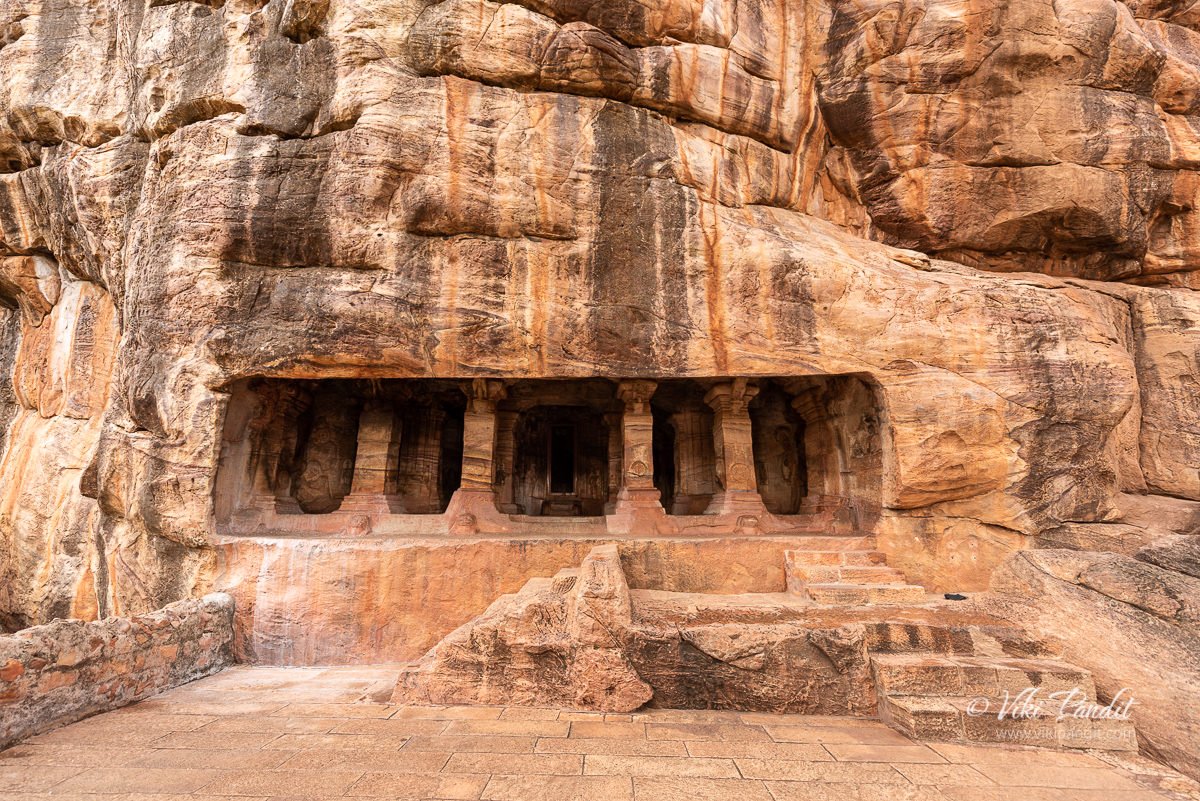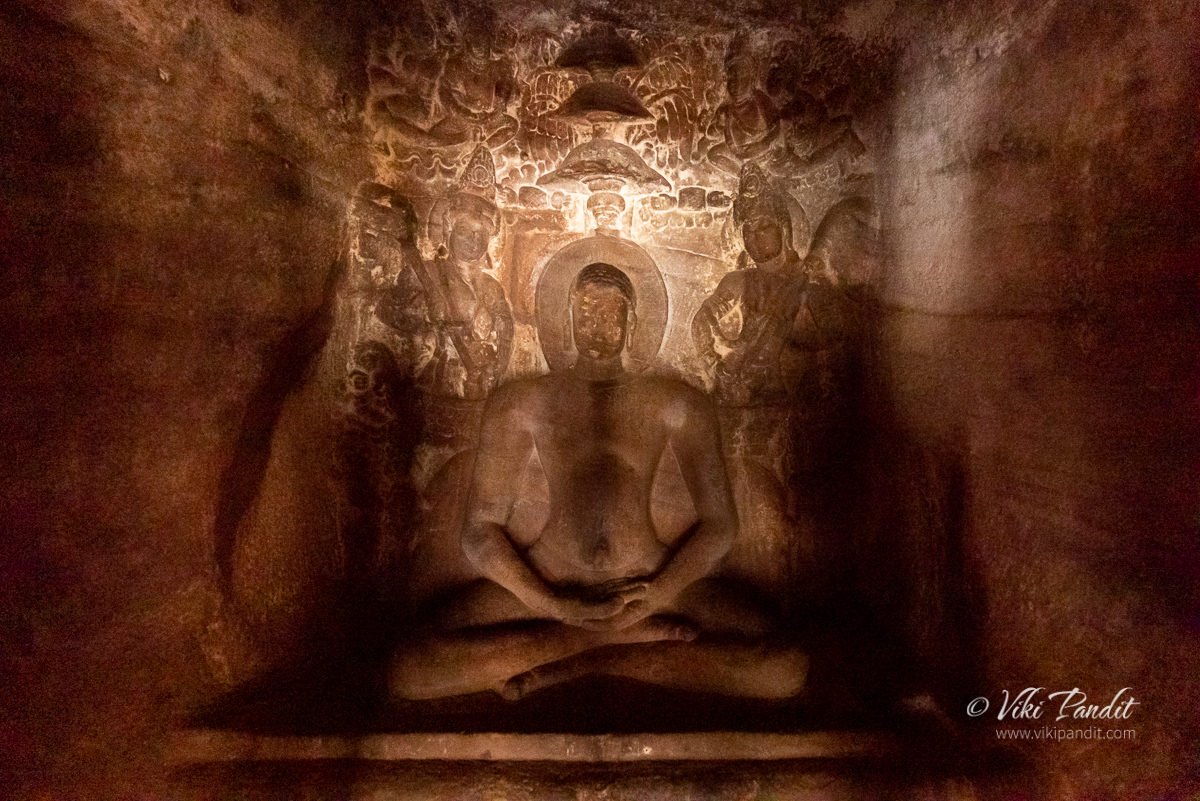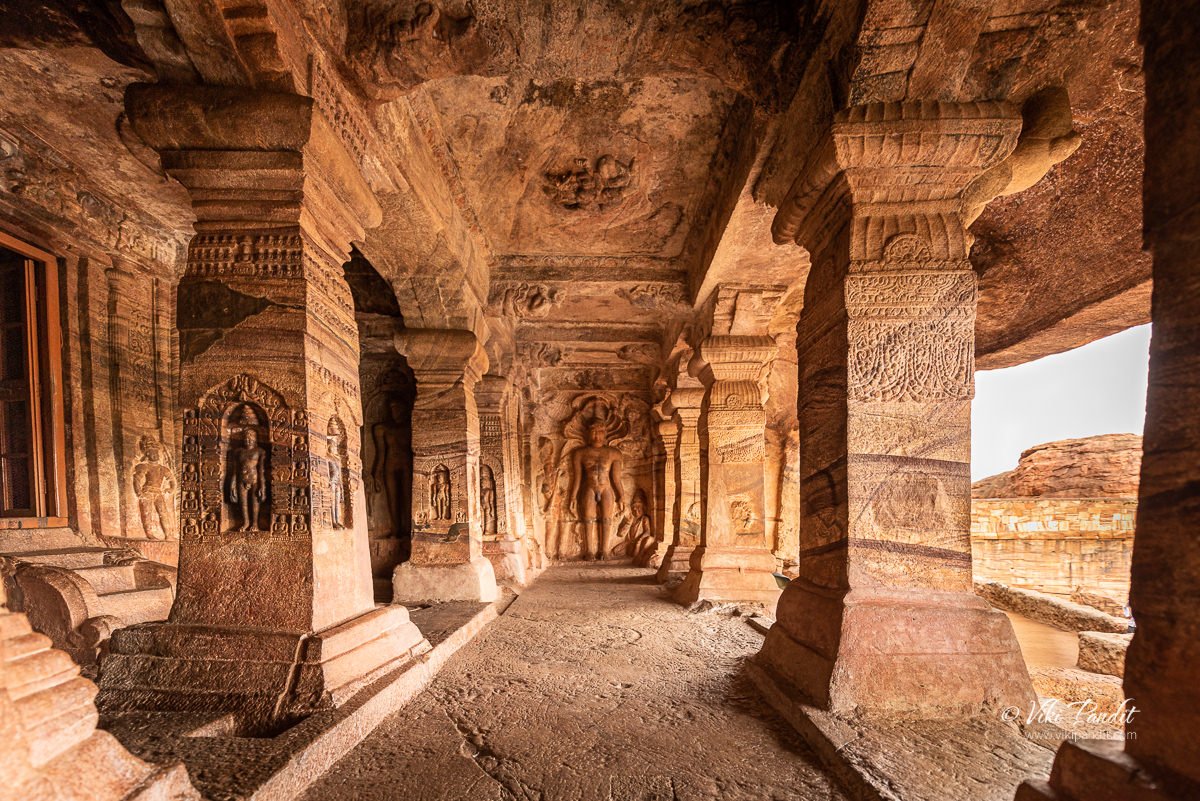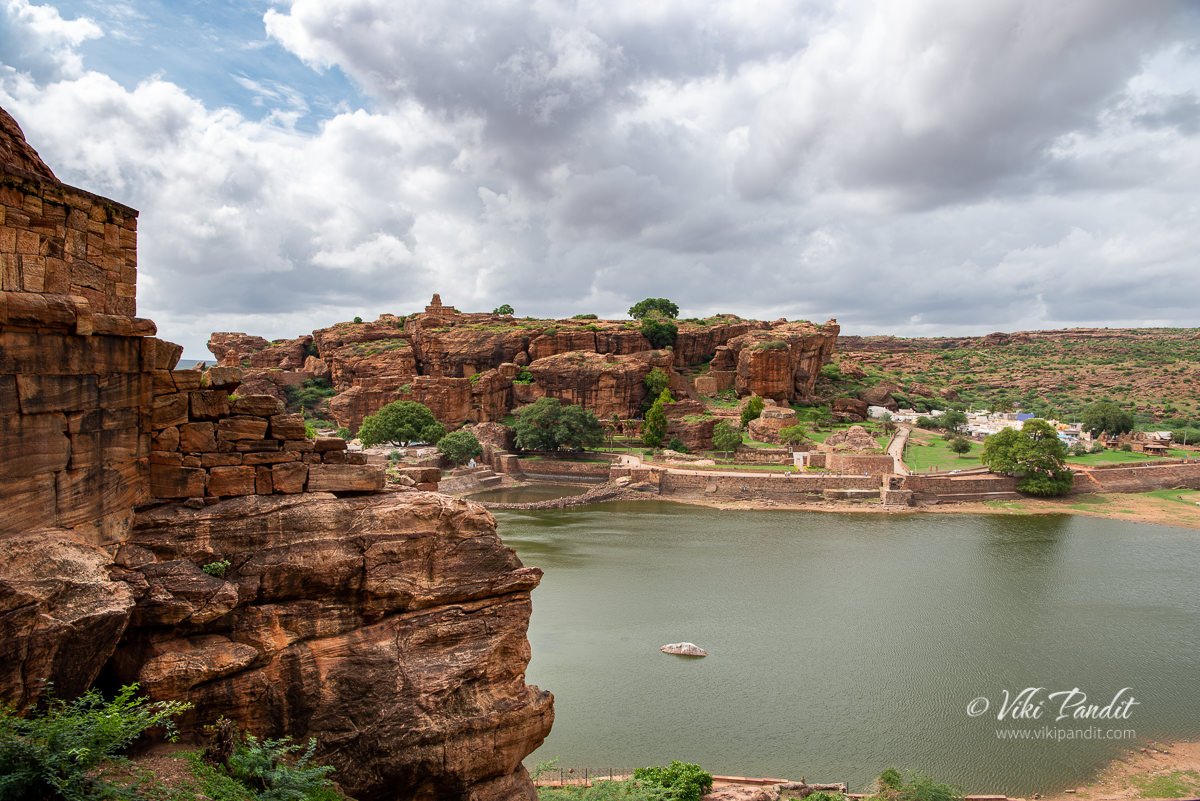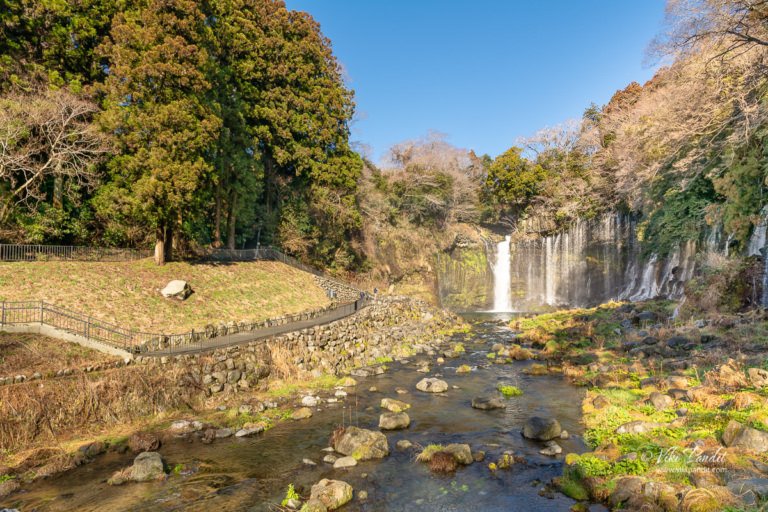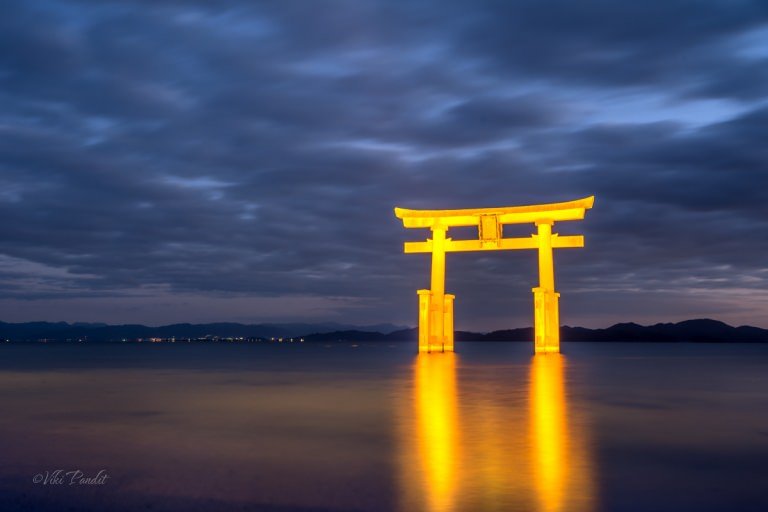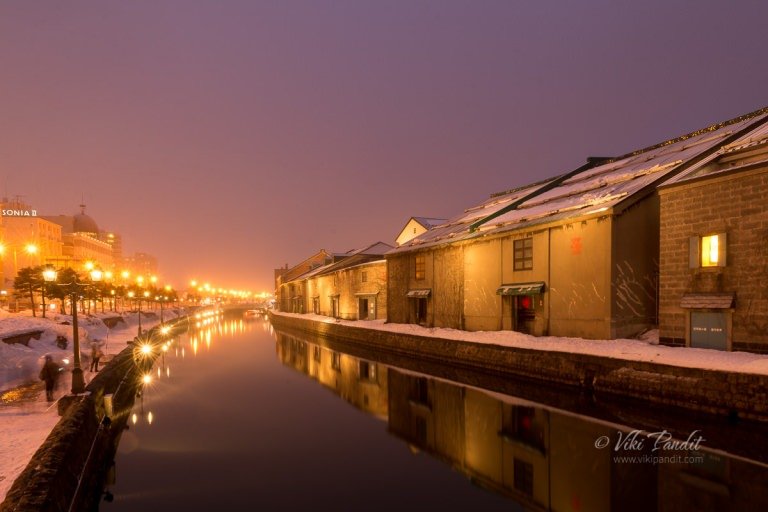Today we hike up a small hill in the quaint town of Badami, in northern Karnataka. Along the hike, we will be exploring four rock-cut cave temples dating back to the 6th century. These temples were primarily commissioned during the times of Chalukya reign (543 CE – 757 CE), and they provide a deep insight into an emerging architecture that influenced the next generation of sculpturing style in the surrounding regions of southern India.
I and my wife, Mani, were staying at Clark’s Inn, which in my opinion is the best hotel in this area. It is also a good base if you have the nearby hotspots like Aihole and Pattadakal planned in your itinerary. Both heritage sites are located within an hour’s drive from Badami.
Historically, Badami has been known by many names. During the reign of Early Chalukyas, it was known as Vatapi. With the passing of time, it came to be referred to as Vatapipura, Vatapinagari, and also Agastya Tirtha. The city lies at the exit point of a ravine between two steep mountain cliffs. The cave temples that we will explore today, lie on the southern cliff.
The road leading to the entrance of the ASI protected site is filthy with dirty slums and pigs loitering around. But once you enter the parking lot, it gets a lot cleaner. The parking lot is located at the base of the hill that hosts all of the 4 Cave temples, each at a different height.
The Badami cave temples represent some of the earliest known examples of Hindu temples in the Deccan region. The temples are numbered 1 to 4 in the order of their ascedency. It is universally agreed that these ancient creations, along with the temples in Aihole, transformed the Malaprabha River valley into a cradle of temple architecture that influenced the components of later Hindu temples in southern India. The Badami Caves complex is part of a UNESCO-designated World Heritage Site candidate. I believe the only thing keeping it waiting to get the official nod is the unhealthy encroaching settlement that surrounds the heritage site.
As usual, I would advise tourists, not to pick a weekend to visit this place as it gets overcrowded. Guides are available near the ticket counter on all days. Tickets costs ₹25 per head for adults. There is an additional camera charge of ₹25 for cameras. Even though it is a nominal charge, I find it amusing that ASI is charging for cameras separately but not charging people using phones to take the same pictures.
Cave Temple 1, Badami
Today’s exploration begins from Cave Temple 1, which lies just a few steps up from the parking lot, on an elevated platform. It is about 60ft above ground level on the north-west part of the hill. The Badami cave temples are carved out of soft Badami sandstone. If you have been to Hampi, you can clearly tell that the color of these temples is comparatively much more reddish.
The Badami cave temples are carved out of soft Badami sandstone on a hill cliff.
A ticket checker stands guard at the base. You might also spot a few monkeys near him. Once you climb the first series of steps, you will find yourself on a flat area with another set of stone steps that take you up to the first cave platform. The wall beside the stairs depicts carvings of dwarfish ganas in different postures as if holding the cave floor.
Cave Temple 1 is dedicated to the Hindu God Shiva. This is immediately apparent from the 18-armed carving of the Tandava-dancing Shiva as Nataraja on the right wall even before you enter the cave. Elaborately portrayed with the arms in various poses, the image expresses the dynamic posture of Shiva in his cosmic dance. The image, about 5ft tall, has 18 arms in a form that expresses the dance positions arranged in a geometric pattern depicting the cosmic wheel.
The eighteen arms express Natya mudras (symbolic hand gestures), with some holding objects such as drums, a flame torch, a serpent, a trident, and an axe. The image of Shiva, has his son Ganesha and the bull Nandi by his side.
The verandah of the cave has five columns sculpted with reliefs of flower garlands, foliage, and jewelry. On the opposite side, to my left, standing just outside the entrance of the cave lies a two-handed Shaiva dvarapala (guard) who holds a trident. Below the guard, carved into the wall is a bull-elephant fused image where the creatures share the head. Seen from left it looks like an elephant and from right the same appears to be a bull.
As you enter the cave temple, beside the dvarpala you can find a carved sculpture of Harihara. The 7.75ft high sculpture is portrayed as a single figure where the left half is depicted to be Hindu god Shiva and the right half is Vishnu. He is shown with goddess Parvati on the left side and goddess Lakshmi on the right side. Thus both the halves are with their respective consorts. A closer look will also reveal that the two halves are also with their vahan(vehicles) Nandi , the bull in a human form on the left, and Garuda, again in human form on the right.
Also known as Shankaranarayana (“Shankara” is Shiva, and “Narayana” is Vishnu), Harihara is revered by both Vaishnavites and Shaivites as a form of Supreme God.
Interestingly the early rulers of the Chalukya dynasty were Vaishnavites. In later years they began to worship Shiva. Yet here in a cave dedicated to Shiva, they have commissioned a sculpture of Harihara. Was this figure invented in order to end the controversy between the Vaishnavites and the Shaivites as to whose god was greater?
The first line of pillars in the front of the cave is richly decorated. Inside this cave, the sons of Shiva, Ganesha, and Kartikeya, the god of war and family deity of the Chalukya dynasty, are seen in one of the carved sculptures on the walls of the cave, with Kartikeya riding a peacock.
The roof of the cave has five carved panels with the central panel depicting the Nagaraja, with flying couples on both sides. In the center lies a beautifully carved image of Nagaraja, with a coiled serpent body around a human torso. The head and bust are well-formed and project from the center of the coil.
On either side of the Nagaraja, you can find images of the Vidyadhara couples as well as couples in courtship, some of them in erotic poses. In Hindu epics, Vidyadharas are described as spirits of the air. They are considered Upadevas, or demi-gods. All the figures are adorned with carved ornaments and surrounded by borders with reliefs of animals and birds.
What is most amazing here is that the artisans who carved these beautifully detailed images must have spent years, day in and day out, lying on their back while creating these.
The inner sanctum contains a Shivaling. Facing the Shivaling, in the center of the mandapa lies a headless, seated Nandi facing the garbha ghriya (sacrum sanctum). The light inside the cave is not very good, so I suggest you come during the afternoons when the light is properly able to reach the interiors. Lack of sunlight means the caves are smelly from centuries of dampness.
From the first cave temple, a fleet of stone stairs lead up to the 2nd Cave Temple. There are about 64 steps to the second cave. It’s like baby steps compared to Kuon-ji Temple in Yamanashi, where I did 287 steps, or the Yamadera Temple that took me about 1,015 steps.
Cave Temple 2, Badami
The 2nd Cave Temple is consecrated to Lord Vishnu. It faces towards the north and is comparatively smaller than the first and might I add: less refined. It is believed to have been commissioned in the late 6th or early 7th century. It has been sculpted from a boulder that is almost double in height of the first cave temple. The cave entrance is divided by four square pillars, all carved out of the monolithic stone face. Similar to the first temple, this too sits on an elevated plinth, decorated with a frieze of ganas.
On the extremes of either side of the entrance are standing dvarapalas (guards) holding flowers, not weapons. The pillars here are rather simple in design with reliefs of flowers and jewelry. The pillars also feature amorous couples towards the top.
The roof contains a complex combination of four Vishnu images surrounded by a maze of Swastikas, somewhat similar to what I noticed in the Ramalingeshwara Temple in Avani.
Though the pillars fail to generate much enthusiasm, the two sides have wonderfully sculpted images of the incarnations of Vishnu. On the left, you will find a beautiful relief depicting the legend of Vishnu in his Varaha (boar) avatar rescuing goddess Earth (Bhudevi) from the depths of the cosmic ocean, with a penitent multi-headed Naga (snake) below. Inside the temple are friezes showing stories from Hindu texts such as the Bhagavata Purana.
On the opposite side, we have an equally beautifully sculpted image of Vishnu in the avatar of the Vamana. This relief in Cave Temple 2, depicts the legend of Vishnu in his Trivikrama form, taking one of the three steps. Below the raised step is a frieze showing the legend of Vamana (dwarf) avatar of Vishnu, before he morphs into the Trivikrama form.
After exploring the 2nd Cave Temple, we ascended towards the next cave. You may find a number of monkeys leisurely sitting here. Do not engage with them or they might attack you or snatch your bags away. To my surprise, one of them even knows how to open bag zippers.
Midway to the third cave temple, molded by the force of winds, lies a natural cave. I small stairs hidden from view takes you up to the cave.
From this cave, one can get a good view of the wide Agastya Lake at the base of the mountain. It is said to have been formed in the 5th century and many believe that its water has curative properties.
This cave does not feature any prominent sculptures. You can barely make out some figures on the side walls as if something was planned and started but was abandoned midway. A mutilated figure of Padmapani can be found deep inside in this natural cavern.
Steep steps from here ascend to the ramparts that constitute the citadel at the summit of the North Fort. Yes, this hill was at one time upgraded into a fort because of regular raids from the Mughal Sultanate. A small doorway that fits not more than two people at a time leads to a broad paved terrace.
Before you enter the doorway, to the right, lies a tiny building, sandwiched inside the crevasse of what looks like a split in the boulder.
Cave Temple 3, Badami
Facing north, Cave Temple 3 is about 60 steps from Cave 2 and at a higher level. It seems to the most decorated among the three we had already explored. It features Vishnu-related mythology and is also in my opinion the most intricately carved cave on the entire hill. At the entrance wall of Cave 3, there is an inscription in the ancient Kannada language that mentioned that Chalukya ruler Mangalesha son of Pulikesh-I was the founder of these cave temples during circa 578 CE.
Cave 3 is said to be the earliest dated Hindu temple in the Deccan region. It is dedicated to Vishnu. It has intricately carved friezes and giant figures of Trivikrama, Anantasayana, Vasudeva, Varaha, Harihara, and Narasimha. The cave stands raised on a plinth divided by seven columns. The cave’s primary theme is Vaishnavite, though it also shows Harihara on its southern wall. The cave is about 15ft high and supported by 3 rows of six pillars. Each of the pillars contains magnificent pieces of art. These columns randomly feature ganas and amorous couples. The cave shows many Kama scenes in pillar brackets, where a woman and a man are in courtship or mithuna (erotic) embrace.
The temple has been sculpted 48ft deep into the mountain; an added square shrine at the end extends the cave 12ft further inside. The verandah itself is 7ft wide and has four free-standing, carved pillars separating it from the hall. Cave 3 also shows fresco paintings on the ceiling, some of which are faded and broken. You can still see the color green used in these paintings. These are among the earliest known surviving evidence of fresco painting in Indian art. The Hindu god Brahma is seen on Hansa vahana in one of the murals. The wedding of Shiva and Parvati, attended by various Hindu deities is the theme of another.
The columns on the inside of the cave temple are much simpler.
On the left of the entrance, we have a lovely image of Vishnu sitting as Vaikuntha over the coils of Sesha. The multi-hoods of the Sesha shelter the crowned head of Vishnu. To its left is another image of Varaha (man-boar avatar) rescuing earth, just like we saw at the previous cave.
On the right side of the entrance lies an image of the Trivikrama-Vamana. He was known as Trivikrama because he is the one who has conquered the three worlds, Earth, Heaven, and the netherworld. There is an interesting story about this avatar of the Hindu god Vishnu. Vamana was the fifth avatar of Vishnu, He was born as the son of Sage Kashyapa and his wife Aditi. In this avatar, Vishnu was known as Vamana because he was a dwarf.
Indian mythology has long stories about tussles between the Asuras (demons) and Devas (heavenly beings). Bali, an asura, was killed by Indra, the king of the Devas, in the battle. He was brought back to life by Sage Shukra. In his reincarnated life he practiced several sacrifices, becoming powerful with each. He became so mighty that he conquered all the three worlds, driving away the devas from the heavens. As usual, they turned to Lord Vishnu for help. Vishnu in the avatar of the Vamana, went to King Bali and asks for three steps of land measured by his foot as a charity.
When Maha Bali completed the ritual process of donating the land, Lord Vamana assumed his cosmic form (Trivikrama), measured the entire Earth including the nether world by his first step. With his second step, he measured the entire heaven.
When the entire Universe was conquered by just two paces of Vishnu (Vamana) there was no space left in the Universe to keep Vamana’s third pace. When Lord Vamana asked Maha Bali the space to keep his third step, all the pride and vanity of Maha Bali vanished and he had no hesitation in surrendering before Vishnu. He readily offered his own head to keep the Vishnu’s third step. The Vamana immediately placed his third step on the head of Bali and sent him to the nether world.
The image of Trivikrama is accompanied by another two carvings of incarnations of Vishnu – The Narasimha and the Harihara. Might I add, in all my travels to Indian temples, I have never seen Narashimha smiling so cutely.
Cave Temple 4, Badami
From here, separated by a series of small steps, but on a lower height lies the last of the Cave temples. Located immediately next to and east of Cave 3, Cave 4 floor is situated about 10 feet lower and is the smallest of the four. It is the only one dedicated to Tirthankaras, the revered figures of Jainism. It is believed to be constructed after the first three, sponsored by Hindu kings in the latter part of the 7th-century.
Like the other caves, Cave 4 features detailed carvings and a diverse range of motifs. The cave has a five-bayed entrance with four square columns.
Inside the temple, behind a narrow door sits a carving of the Mahavira. At each corner you will find carvings of Bahubali, Parshvanatha and Mahavira with symbolic displays of other Tirthankaras.
Mahavira is enshrined as the main deity. Because of the narrow door and no other light source, it was tough to capture it in the darkness.
To the left, right at the entrance, you can find Bahubali, standing in Kayotsarga meditating posture with vines wrapped around his leg, his classic iconography. Bahubali was a prince who attained the stature of a perfected being (siddha). Although never admitted to the pantheon of twenty-four tirthankaras, he nonetheless attained jina-like status. The legend of Bahubali tells of a prince who renounces violence after coming close to slaying his brother Bharata in a battle of succession and then renounces pride and its expression – violence to other living creatures. Embracing ahimsa (nonviolence), he meditates in the “body-abandonment” posture in a forest, where he is entwined by vines and hosts birds that nest in his hair until he attains moksha.
On the right, just opposite the Bahubali image, you will find a detailed image of Parshavanata, with a multi-hooded cobra rising over its head.
The carvings on the pillars are different here from the other cave temples. The first row features floral motifs along with circular carvings of amorous couples. If you look closely, it seems that some of the more erotic carvings on the pillars have been scooped out.
The second row of pillars features detailed carvings of Mahavira embedded into a surrounding carving depicting a gate of sorts. This divergence of design leads to much speculation about the time of the creation of this temple.
After exploring the cave, we took a small breather at the top. From the podium in front of the 4th Cave temple, you can get some lovely shots of the expanse that surrounds Badami.
Other than the numbered caves, Badami is home to many other cave monuments and medieval era temples. On the other side of the lake, near the Bhutanatha temple, is a 7th-8th century Chalukya period cave of small dimensions. You can visit Badami all round the year except mid-Summer when it gets extremely hot. I would recommend going just after monsoon when the Agastya lake is brimming with crystal clear water and adds a nice charm to the heritage site
Please note, you will find many monkeys along the hike. Do not carry food and make sure your bags are tightly wrapped as they will try to snatch it and run away.
Just beneath the Cave temple complex, the man-made Agastya teertha or lake is situated which looks like a ravine of crystal clear water surrounded by the greenery and hills of yellow sandstone.
Thanks for reading. I look forward to your comments and questions. If you are looking to explore more of the Badami region, follow my story as I hike to the ruins of the Shivalayas of Badami. If you are in Karnataka do not miss these interesting heritage sites around Bangalore.
The Badami Cave Temples were built in the 6th century.
The Badami Cave Temples were commissioned by the Chalukya kings
The entry fees of Badami Cave Temples is ₹25 per person for Indian Nationals and ₹100 per person for Foreigners.
Disclaimer: The information presented in this article is based on the time I visited the premises. Note that there might be changes in the prices of merchandise and admission fees that might have occurred after this article was published. At times the facility might also be closed for repairs or for variety of other reasons. Kindly contact the facility or facilities mentioned in this article directly before visiting.
Usage of this site indicates acceptance of my Terms and Conditions.
Credits: The historical information presented herein is gathered mostly from local guides that were re-inforced via historical writings.
